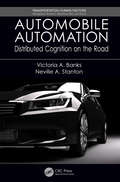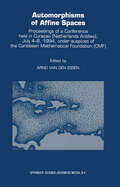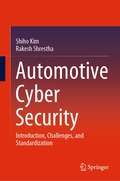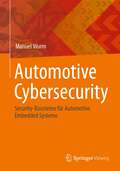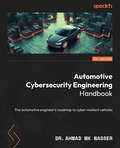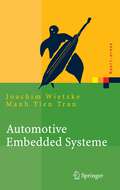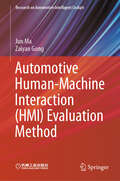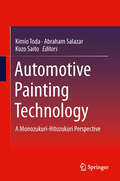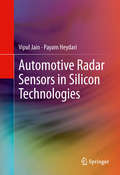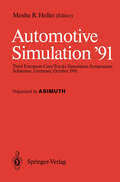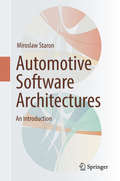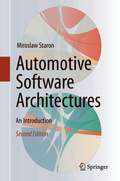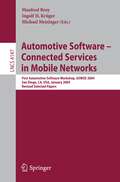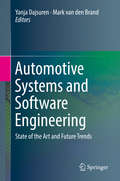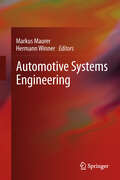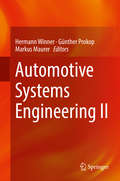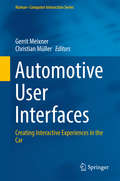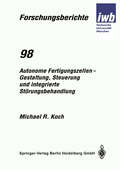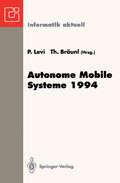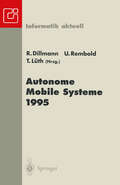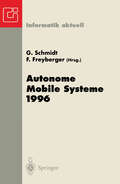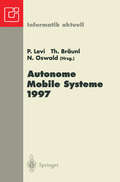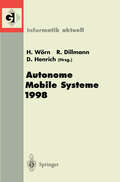- Table View
- List View
Automobile Automation: Distributed Cognition on the Road (Transportation Human Factors)
by Victoria A. Banks Neville A. StantonIncreasing levels of driving automation has changed the role of the driver from active operator to passive monitor. However, Systems Design has been plagued by criticism for failing to acknowledge the new role of the driver within the system network. To understand the driver's new role within an automated driving system, the theory of Distributed Cognition is adopted. This approach provides a useful framework for the investigation of allocation of function between multiple agents in the driving system. A Systems Design Framework has been developed that outlines how the Distributed Cognition paradigm can be applied to driving using both qualitative and quantitative research methodologies.
Automobile Automation: Distributed Cognition on the Road (Transportation Human Factors)
by Victoria A. Banks Neville A. StantonIncreasing levels of driving automation has changed the role of the driver from active operator to passive monitor. However, Systems Design has been plagued by criticism for failing to acknowledge the new role of the driver within the system network. To understand the driver's new role within an automated driving system, the theory of Distributed Cognition is adopted. This approach provides a useful framework for the investigation of allocation of function between multiple agents in the driving system. A Systems Design Framework has been developed that outlines how the Distributed Cognition paradigm can be applied to driving using both qualitative and quantitative research methodologies.
Automorphisms of Affine Spaces
by Arno Van Den EssenAutomorphisms of Affine Spaces describes the latest results concerning several conjectures related to polynomial automorphisms: the Jacobian, real Jacobian, Markus-Yamabe, Linearization and tame generators conjectures. Group actions and dynamical systems play a dominant role. Several contributions are of an expository nature, containing the latest results obtained by the leaders in the field. The book also contains a concise introduction to the subject of invertible polynomial maps which formed the basis of seven lectures given by the editor prior to the main conference. Audience: A good introduction for graduate students and research mathematicians interested in invertible polynomial maps.
Automotive Cyber Security: Introduction, Challenges, and Standardization
by Shiho Kim Rakesh ShresthaThis book outlines the development of safety and cybersecurity, threats and activities in automotive vehicles. This book discusses the automotive vehicle applications and technological aspects considering its cybersecurity issues. Each chapter offers a suitable context for understanding the complexities of the connectivity and cybersecurity of intelligent and autonomous vehicles. A top-down strategy was adopted to introduce the vehicles’ intelligent features and functionality. The area of vehicle-to-everything (V2X) communications aims to exploit the power of ubiquitous connectivity for the traffic safety and transport efficiency. The chapters discuss in detail about the different levels of autonomous vehicles, different types of cybersecurity issues, future trends and challenges in autonomous vehicles. Security must be thought as an important aspect during designing and implementation of the autonomous vehicles to prevent from numerous security threats and attacks. The book thus provides important information on the cybersecurity challenges faced by the autonomous vehicles and it seeks to address the mobility requirements of users, comfort, safety and security. This book aims to provide an outline of most aspects of cybersecurity in intelligent and autonomous vehicles. It is very helpful for automotive engineers, graduate students and technological administrators who want to know more about security technology as well as to readers with a security background and experience who want to know more about cybersecurity concerns in modern and future automotive applications and cybersecurity. In particular, this book helps people who need to make better decisions about automotive security and safety approaches. Moreover, it is beneficial to people who are involved in research and development in this exciting area. As seen from the table of contents, automotive security covers a wide variety of topics. In addition to being distributed through various technological fields, automotive cybersecurity is a recent and rapidly moving field, such that the selection of topics in this book is regarded as tentative solutions rather than a final word on what exactly constitutes automotive security. All of the authors have worked for many years in the area of embedded security and for a few years in the field of different aspects of automotive safety and security, both from a research and industry point of view.
Automotive Cybersecurity: Security-Bausteine für Automotive Embedded Systeme
by Manuel WurmDie aktuellen technologischen Veränderungen, allen voran die Digitalisierung, die Vernetzung von Verkehrssystemen und das Autonome Fahren, schaffen einerseits neue Mobilitätslösungen, andererseits rücken dadurch Fahrzeuge und die Automotive Infrastruktur als zunehmend attraktive Angriffsziele in den Fokus von Hackern und Cyberkriminellen. Die höhere Komplexität elektronischer Systeme hat eine größere Angriffsoberfläche zur Folge. Ein strukturierter und ganzheitlicher Ansatz macht diese Herausforderung beherrschbar. Dieses Buch verschafft dem Leser einen Überblick über die für ein umfassendes Securitykonzept erforderlichen Security-Bausteine. Die detaillierte Darstellung verschiedener Security-Mechanismen beschreibt einerseits wie Fahrzeugsysteme vor bestimmten Angriffen geschützt werden und macht andererseits deutlich, welche Herausforderungen und Abhängigkeiten deren Implementierung in ein Automotive Deeply-Embedded System mit sich bringt.
Automotive Cybersecurity Engineering Handbook: The automotive engineer's roadmap to cyber-resilient vehicles
by Dr. Ahmad NasserAccelerate your journey of securing safety-critical automotive systems through practical and standard-compliant methodsKey FeaturesUnderstand how automotive systems can become vulnerable to cyberattacksApply security controls to all vehicle layers for mitigating cybersecurity risksFind out how systematic secure engineering mitigates cyber risks while ensuring compliancePurchase of the print or Kindle book includes a free PDF eBookBook DescriptionReplete with exciting challenges, automotive cybersecurity is an emerging domain, and cybersecurity is a foundational enabler for current and future connected vehicle features. This book addresses the severe talent shortage faced by the industry in meeting the demand for building cyber-resilient systems by consolidating practical topics on securing automotive systems to help automotive engineers gain a competitive edge. The book begins by exploring present and future automotive vehicle architectures, along with relevant threats and the skills essential to addressing them. You’ll then explore cybersecurity engineering methods, focusing on compliance with existing automotive standards while making the process advantageous. The chapters are designed in a way to help you with both the theory and practice of building secure systems while considering the cost, time, and resource limitations of automotive engineering. The concluding chapters take a practical approach to threat modeling automotive systems and teach you how to implement security controls across different vehicle architecture layers. By the end of this book, you'll have learned effective methods of handling cybersecurity risks in any automotive product, from single libraries to entire vehicle architectures.What you will learnGet to grips with present and future vehicle networking technologiesExplore basic concepts for securing automotive systemsDiscover diverse approaches to threat modeling of systemsConduct efficient threat analysis and risk assessment (TARA) for automotive systems using best practicesGain a comprehensive understanding of ISO/SAE 21434's cybersecurity engineering approachImplement cybersecurity controls for all vehicle life cyclesMaster ECU-level cybersecurity controlsWho this book is forIf you’re an engineer wondering where to get started in the field of automotive cybersecurity or trying to understand which security standards apply to your product and how, then this is the book for you. This book is also for experienced engineers looking for a practical approach to automotive cybersecurity development that can be achieved within a reasonable time frame while leveraging established safety and quality processes. Familiarity with basic automotive development processes across the V-model will help you make the most of this book.
Automotive Cybersecurity Engineering Handbook: The automotive engineer's roadmap to cyber-resilient vehicles
by Dr. Ahmad NasserAccelerate your journey of securing safety-critical automotive systems through practical and standard-compliant methodsKey FeaturesUnderstand how automotive systems can become vulnerable to cyberattacksApply security controls to all vehicle layers for mitigating cybersecurity risksFind out how systematic secure engineering mitigates cyber risks while ensuring compliancePurchase of the print or Kindle book includes a free PDF eBookBook DescriptionReplete with exciting challenges, automotive cybersecurity is an emerging domain, and cybersecurity is a foundational enabler for current and future connected vehicle features. This book addresses the severe talent shortage faced by the industry in meeting the demand for building cyber-resilient systems by consolidating practical topics on securing automotive systems to help automotive engineers gain a competitive edge. The book begins by exploring present and future automotive vehicle architectures, along with relevant threats and the skills essential to addressing them. You’ll then explore cybersecurity engineering methods, focusing on compliance with existing automotive standards while making the process advantageous. The chapters are designed in a way to help you with both the theory and practice of building secure systems while considering the cost, time, and resource limitations of automotive engineering. The concluding chapters take a practical approach to threat modeling automotive systems and teach you how to implement security controls across different vehicle architecture layers. By the end of this book, you'll have learned effective methods of handling cybersecurity risks in any automotive product, from single libraries to entire vehicle architectures.What you will learnGet to grips with present and future vehicle networking technologiesExplore basic concepts for securing automotive systemsDiscover diverse approaches to threat modeling of systemsConduct efficient threat analysis and risk assessment (TARA) for automotive systems using best practicesGain a comprehensive understanding of ISO/SAE 21434's cybersecurity engineering approachImplement cybersecurity controls for all vehicle life cyclesMaster ECU-level cybersecurity controlsWho this book is forIf you’re an engineer wondering where to get started in the field of automotive cybersecurity or trying to understand which security standards apply to your product and how, then this is the book for you. This book is also for experienced engineers looking for a practical approach to automotive cybersecurity development that can be achieved within a reasonable time frame while leveraging established safety and quality processes. Familiarity with basic automotive development processes across the V-model will help you make the most of this book.
Automotive Embedded Systeme: Effizfientes Framework - Vom Design zur Implementierung (Xpert.press)
by Joachim Wietzke Manh Tien TranDie Entwicklung hochkomplexer automotiver Infotainmentsysteme bestehend aus einer Headunit und weiteren Komponenten wie Audio- und Videoelementen, Kommunikationseinheiten, Navigationssystemen und Sensorik erfordert solides Domänenwissen und umfassendes Know-how im Software-Engineering. Das vorliegende Buch gibt eine fundierte Darstellung der softwareseitigen Implementierung dieser Komponenten innerhalb eines komplexen Frameworks. Im ersten Teil des Buches werden wichtige Grundlagen zu Eingebetteten Systemen und den für diese Systeme charakteristischen Methoden des Software-Engineerings vermittelt. Insbesondere werden dabei die Themen Speichermanagement und Systemperformance sowie grundlegende Mechanismen von Betriebssystemen betrachtet. Im zweiten Teil wird eine konkrete, objektorientierte Implementierung eines Frameworks dargestellt. Diese Implementierung zeigt die Umsetzung besonders effizienter Sychronisations- und Kommunikationsprozesse innerhalb einer kompakten und hochperformanten Systemarchitektur.
Automotive Human-Machine Interaction (Research on Automotive Intelligent Cockpit)
by Jun Ma Zaiyan GongThis book focuses on the evaluation methodology for automotive human-machine interaction (HMI), which aim to reduce driving distractions, lower operational loads, optimize user experience design, and enhance user value.The book is divided into three parts. The first part, consisting of Chapters 1–3, introduces the evolution of automotive HMI and proposes a three-dimensional orthogonal evaluation system for automotive HMI that is comprehensive, systematic, and quantifiable. This evaluation system incorporates all evaluation items into a spatial matrix consisting of three dimensions: interaction tasks, interaction modalities, and evaluation indexes. The second part provides a comprehensive presentation and in-depth discussion of the evaluation indexes. The three rational evaluation indexes are utility, safety, and efficiency, which can be tested by the real-car driving simulator. The four emotional evaluation indexes are cognition, intelligence, value, and aesthetics. In orderto standardize the latter two subjective indexes, this book summarizes common differences in value between Chinese and European users and organizes typical aesthetic orientations in automotive UI based on art history research. The third part introduces the application of this HMI evaluation system in the automotive R&D process, including how to integrate the evaluation into a real product development process to achieve efficient product iteration.This book is suitable for intelligent cockpit and HMI designers, engineers, and researchers. It is also used as a reference for product managers and students in the field of intelligent connected vehicles.
Automotive Painting Technology: A Monozukuri-Hitozukuri Perspective
by Kimio Toda, Abraham Salazar and Kozo SaitoThis book offers unique and valuable contributions to the field. It offers breadth and inclusiveness. Most existing works on automotive painting cover only a single aspect of this complex topic, such as the chemistry of paint or paint booth technology. Monozukuri and Hitozukuri are Japanese terms that can be translated as “making things” and “developing people” but their implications in Japanese are richer and more complex than this minimal translation would indicate. The Monozukuri-Hitozukuri perspective is drawn from essential principles on which the Toyota approach to problem-solving and continuous improvement is based. From this perspective, neither painting technology R&D nor painting technology use in manufacturing can be done successfully without integrating technological and human concerns involved with making and learning in the broadest sense, as the hyphen is meant to indicate. The editors provide case studies and examples -- drawn from Mr. Toda’s 33 years of experience with automotive painting at Toyota and from Dr. Saito’s 18 years experience with IR4TD, the research-for-development group he leads at the University of Kentucky -- that give details on how these two principles can be integrated for successful problem-solving and innovation in industry, in university R&D, and in the collaboration between the two. The book will bring readers up to date on progress in the field over the last decade to provide a basis for and to indicate fruitful directions in future R&D and technology innovation for automotive painting.
Automotive Radar Sensors in Silicon Technologies
by Vipul Jain Payam HeydariOne of the leading causes of automobile accidents is the slow reaction of the driver while responding to a hazardous situation. State-of-the-art wireless electronics can automate several driving functions, leading to significant reduction in human error and improvement in vehicle safety. With continuous transistor scaling, silicon fabrication technology now has the potential to substantially reduce the cost of automotive radar sensors. This book bridges an existing gap between information available on dependable system/architecture design and circuit design. It provides the background of the field and detailed description of recent research and development of silicon-based radar sensors. System-level requirements and circuit topologies for radar transceivers are described in detail. Holistic approaches towards designing radar sensors are validated with several examples of highly-integrated radar ICs in silicon technologies. Circuit techniques to design millimeter-wave circuits in silicon technologies are discussed in depth.
Automotive Simulation ’91: Proceedings of the 3rd European Cars/Trucks, Simulation Symposium Schliersee, Germany, October 1991
by Moshe R. HellerWelcome to Bavaria - Germany - to the THIRD EUROPEAN CARS/TRUCKS SIMULATION SYMPOSIUM. That Schliersee traditional workshop-type meeting is a follow-up to the first and the second symposia which took place in May 1984 and May 1989 respectively. The objective of gathering together is to cover most of the aspects of Automotive Mathematical Modelling and Simulation in theory and practice to promote the exchange of knowledge and experience between different national and international research groups in that field, taking into consideration that every seventh German employee is related to the automotive industry. This effect is also in power at least with the traditional Detroit (U.S.A.) Automotive Industries and the growing up Japanease as well. Futhermore, there is to strenghten the international contact between developers and users of modelling and simulation techniques considering the "new world order" started in 1991 with no borders between West and East affected by the Golf-War and followed up by the "open" European Community borders of 1992. VI The traditional International Conference jointly promoted by ASIMUTH - Applied Simulation Technology and some other members of the Society of Computer Simulaton created an interest to publish new projects including their results. A large number of contributed papers has been strictly examined and selected by the editorial commitee to guarantee a high international technical standard.
Automotive Software Architectures: An Introduction
by Miroslaw StaronThis book introduces the concept of software architecture as one of the cornerstones of software in modern cars. Following a historical overview of the evolution of software in modern cars and a discussion of the main challenges driving that evolution, Chapter 2 describes the main architectural styles of automotive software and their use in cars’ software. In Chapter 3, readers will find a description of the software development processes used to develop software on the car manufacturers’ side. Chapter 4 then introduces AUTOSAR – an important standard in automotive software. Chapter 5 goes beyond simple architecture and describes the detailed design process for automotive software using Simulink, helping readers to understand how detailed design links to high-level design. Next, Chapter 6 presents a method for assessing the quality of the architecture – ATAM (Architecture Trade-off Analysis Method) – and provides a sample assessment, while Chapter 7 presents an alternative way of assessing the architecture, namely by using quantitative measures and indicators. Subsequently Chapter 8 dives deeper into one of the specific properties discussed in Chapter 6 – safety – and details an important standard in that area, the ISO/IEC 26262 norm. Lastly, Chapter 9 presents a set of future trends that are currently emerging and have the potential to shape automotive software engineering in the coming years.This book explores the concept of software architecture for modern cars and is intended for both beginning and advanced software designers. It mainly aims at two different groups of audience – professionals working with automotive software who need to understand concepts related to automotive architectures, and students of software engineering or related fields who need to understand the specifics of automotive software to be able to construct cars or their components. Accordingly, the book also contains a wealth of real-world examples illustrating the concepts discussed and requires no prior background in the automotive domain.
Automotive Software Architectures: An Introduction
by Miroslaw StaronThis book introduces the concept of software architecture as one of the cornerstones of software in modern cars. Following a historical overview of the evolution of software in modern cars and a discussion of the main challenges driving that evolution, Chapter 2 describes the main architectural styles of automotive software and their use in cars’ software. Chapter 3 details this further by presenting two modern architectural styles, i.e. centralized and federated software architectures. In Chapter 4, readers will find a description of the software development processes used to develop software on the car manufacturers’ side. Chapter 5 then introduces AUTOSAR – an important standard in automotive software. Chapter 6 goes beyond simple architecture and describes the detailed design process for automotive software using Simulink, helping readers to understand how detailed design links to high-level design. The new chapter 7 reports on how machine learning is exploited in automotive software e.g. for image recognition and how both on-board and off-board learning are applied. Next, Chapter 8 presents a method for assessing the quality of the architecture – ATAM (Architecture Trade-off Analysis Method) – and provides a sample assessment, while Chapter 9 presents an alternative way of assessing the architecture, namely by using quantitative measures and indicators. Subsequently Chapter 10 dives deeper into one of the specific properties discussed in Chapter 8 – safety – and details an important standard in that area, the ISO/IEC 26262 norm. Lastly, Chapter 11 presents a set of future trends that are currently emerging and have the potential to shape automotive software engineering in the coming years. This book explores the concept of software architecture for modern cars and is intended for both beginning and advanced software designers. It mainly aims at two different groups of audience – professionals working with automotive software who need to understand concepts related to automotive architectures, and students of software engineering or related fields who need to understand the specifics of automotive software to be able to construct cars or their components. Accordingly, the book also contains a wealth of real-world examples illustrating the concepts discussed and requires no prior background in the automotive domain. Compared to the first edition, besides the two new chapters 3 and 7 there are considerable updates in chapters 5 and 8 especially.
Automotive Software-Connected Services in Mobile Networks: First Automotive Software Workshop, ASWSD 2004, San Diego, CA, USA, January 10-12, 2004, Revised Selected Papers (Lecture Notes in Computer Science #4147)
by Manfred Broy Ingolf Krüger Michael MeisingerThis book constitutes the thoroughly refereed post-proceedings of the First Automotive Software Workshop, ASWD 2004, held in San Diego, CA, USA in January 2004. The 10 revised full papers presented were carefully reviewed and selected from 26 lectures held at the workshop that brought together experts from industry and academia, working on highly complex, distributed, reactive software systems related to the automotive domain.
Automotive Systems and Software Engineering: State of the Art and Future Trends
This book presents the state of the art, challenges and future trends in automotive software engineering. The amount of automotive software has grown from just a few lines of code in the 1970s to millions of lines in today’s cars. And this trend seems destined to continue in the years to come, considering all the innovations in electric/hybrid, autonomous, and connected cars. Yet there are also concerns related to onboard software, such as security, robustness, and trust.This book covers all essential aspects of the field. After a general introduction to the topic, it addresses automotive software development, automotive software reuse, E/E architectures and safety, C-ITS and security, and future trends. The specific topics discussed include requirements engineering for embedded software systems, tools and methods used in the automotive industry, software product lines, architectural frameworks, various related ISO standards, functional safety and safety cases, cooperative intelligent transportation systems, autonomous vehicles, and security and privacy issues.The intended audience includes researchers from academia who want to learn what the fundamental challenges are and how they are being tackled in the industry, and practitioners looking for cutting-edge academic findings. Although the book is not written as lecture notes, it can also be used in advanced master’s-level courses on software and system engineering. The book also includes a number of case studies that can be used for student projects.
Automotive Systems Engineering
by Markus Maurer and Hermann WinnerThis book reflects the shift in design paradigm in automobile industry. It presents future innovations, often referred as “automotive systems engineering”. These cause fundamental innovations in the field of driver assistance systems and electro-mobility as well as fundamental changes in the architecture of the vehicles. New driving functionalities can only be realized if the software programs of multiple electronic control units work together correctly. This volume presents the new and innovative methods which are mandatory to master the complexity of the vehicle of the future.
Automotive Systems Engineering II
by Hermann Winner Günther Prokop Markus MaurerThis book is the second volume reflecting the shift in the design paradigm in automobile industry. It presents contributions to the second and third workshop on Automotive Systems Engineering held in March 2013 and Sept. 2014, respectively.It describes major innovations in the field of driver assistance systems and automated vehicles as well as fundamental changes in the architecture of the vehicles.
Automotive User Interfaces: Creating Interactive Experiences in the Car (Human–Computer Interaction Series)
by Gerrit Meixner Christian MüllerThis book focuses on automotive user interfaces for in-vehicle usage, looking at car electronics, its software of hidden technologies (e.g., ASP, ESP), comfort functions (e.g., navigation, communication, entertainment) and driver assistance (e.g., distance checking). The increased complexity of automotive user interfaces, driven by the need for using consumer electronic devices in cars as well as autonomous driving, has sparked a plethora of new research within this field of study. Covering a broad spectrum of detailed topics, the authors of this edited volume offer an outstanding overview of the current state of the art; providing deep insights into usability and user experience, interaction techniques and technologies as well as methods, tools and its applications, exploring the increasing importance of Human-Computer-Interaction (HCI) within the automotive industry Automotive User Interfaces is intended as an authoritative and valuable resource for professional practitioners and researchers alike, as well as computer science and engineering students who are interested in automotive interfaces.
Autonome Fertigungszellen — Gestaltung, Steuerung und integrierte Störungsbehandlung (iwb Forschungsberichte #98)
by Michael R. KochAutonome Mobile Systeme 1994: 10. Fachgespräch, Stuttgart, 13. und 14. Oktober 1994 (Informatik aktuell)
by Paul Levi Thomas BräunlAutonome Mobile Systeme 1995: 11. Fachgespräch Karlsruhe, 30. November-1. Dezember 1995 (Informatik aktuell)
by Rüdiger Dillmann Ulrich Rembold Tim LüthAutonome Mobile Systeme 1996: 12. Fachgespräch München, 14.–15. Oktober 1996 (Informatik aktuell)
by Günther Schmidt Franz Freybergermit Sonderbeiträgen zu den technischen Demonstrationen aus dem Sonderforschungsbereich 331 "Informationsbearbeitung in autonomen, mobilen Handhabungssystemen" an der Technischen Universität München
Autonome Mobile Systeme 1997: 13. Fachgespräch, Stuttgart, 6.–7. Oktober 1997 (Informatik aktuell)
by Paul Levi Thomas Bräunl Norbert OswaldDas Werk bietet einen Überblick über die aktuelle Forschung auf dem Gebiet der Robotik. Das Spektrum reicht von neuen Anwendungen von Servicerobotern bis zur Analyse von Multirobotersystemen, bei denen Aspekte der Kooperation und Simulation im Vordergrund stehen.
Autonome Mobile Systeme 1998: 14. Fachgespräch Karlsruhe, 30. November-1. Dezember 1998 (Informatik aktuell)
by Heinz Wö Rüdiger Dillmann Dominik HenrichVor 13 Jahren fand im November 1985 an der Universität Karlsruhe erstmals das Fachgespräch über "Autonome Mobile Systeme" statt. Seither wird es regelmäßig jedes Jahr alternierend einmal in München, Karlsruhe und seit 1994 auch in Stuttgart abgehalten. Diese Tradition entwickelte sich insbesondere durch Forschungs schwerpunkte, Verbundprojekte und Sonderforschungsbereiche, die an diesen Universitäten zu dem Thema autonome Systeme bearbeitet wurden, aktuell laufen oder in Planung sind. Im Dezember 1998 findet das 14. Fachgespräch "Autonome Mobile Systeme" (AMS'98) nunmehr das siebte Mal in Karlsruhe statt. Das Fachgespräch versteht sich als kritisches wissenschaftliches Forum im deutschsprachigen Raum, auf dem Arbeiten aus Universitäten und Fachhochschulen, Forschungseinrichtungen und Firmen auf dem Gebiet der autonomen mobilen Robotersysteme vorgestellt, diskutiert und neue Ideen aufgegriffen werden. Mit Freude können die Veranstalter darauf verweisen, daß auch internationale Gäste in das Fachgespräch eingebunden werden konnten. Bei den bisherigen Fachgesprächen zeigte sich deutlich, daß sich der Begriff der Autonomie von Robotersystemen ständig ändert und von den Anforderungen der jeweiligen Anwendung geprägt wird. Zu Beginn der Fachgesprächsreihe standen autonome Fahrzeuge in industriellen Produktionsbereichen im Vordergrund. Im Jahr 1998 zeigt das Spektrum der Beiträge, daß Autonomie auch ein Grundbestandteil von Straßen-, Gelände- Wasser- und Luftfahrzeugen wird. Die Forschung auf dem Gebiet autonomer mobiler Roboter konzentriert sich zunehmend auf den Bereich Serviceroboter. So wurden auf der Hannover-Messe in diesem Jahr auf dem Gemeinschaftsstand Serviceroboter zahlreiche mobile Plattformen für Roboteranwendungen in unterschiedlichen Dienstleistungsbereichen wie Büro, Hotel, Krankenhaus und gar im privaten Umfeld vorgestellt.
